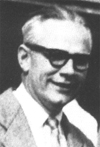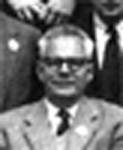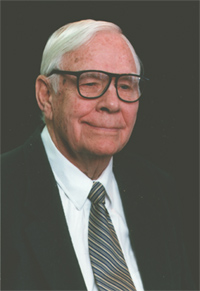My introduction to quantum chemistry occurred as an undergraduate member
of Farrington Daniel's research group at the University of Wisconsin in 1935.
Albert Sherman, a post-doc member of the group, gave a series of informal lectures which provided a marvelous introduction to the subject. He had just finished writing (with J. H. Van Vleck) "The Quantum Theory of Valence" [Rev. Mod. Phys. 7, 167 (1935)]. The following quotation from this article made a lasting impression on me:
"Actually the only forces between spin are magnetic forces
which are exceedingly small, and the only reason that spin
figures in the answer is that the constraints imposed by the
Pauli principle correlate different spin alignments with different
electrostatic exchange energies.
Thus spin is only an indicator ... " (emphasis by FAM)
Al {Sherman, website note} had taken his degree with Henry Eyring at Princeton, so that it was only natural that I should do the same. The Princeton faculty in 1937 was very impressive with people like Einstein, Wigner, Weyl, Eyring, etc. Eyring was a very enthusiastic researcher bubbling over with new ideas. He gave a very good quantum mechanics course which later served as the basis for the Eyring, Walters, and Kimball's Quantum Chemistry (Wiley, New York, 1944).
There were many great seminars, among which I remember George Kimball's outstanding seminar entitled Group Theory of Directed Valence. Among my classmates were John Walters, Walter Kauzman, John Tukey (who became a famous mathematician), and Walter Moore (who has just published a biography of Schrodinger).
After a brief stint at Bucknell, I moved to Texas in 1942 where I have been ever since. My first research was on the theory of liquids, and my first quantum chemistry research was The Molecular Orbital Theory of the Spectra of Monosubstituted Benzenes [1]. I was helped by several summers at the University of Chicago where I interacted with Robert Mulliken, Clemens Roothaan, and John Platt. Robert was a gentle and committed man. I still remember his blackboard being completely covered, but he could always find space to make notations from his conversations. I don't know if the blackboard was ever erased, Clemens was in the process of formulating his famous LCAO-SCF theory. John was active in the interpretation of electronic spectra.
|

Matsen in 1958
|
During that period, quantum chemists assembled at the Ohio State Spectroscopic Conference in Columbus, the precursor of the Sanibel Conference. It was there I met Per-Olov Lowdin, Hertha Sponer, and many other quantum chemists.
My spectral theory [1] was good enough to impress Linus Pauling, who, as a member of the Guggenheim Committee, was responsible for my working with Charles Coulson at King's College London and Oxford in 1951. Coulson was very kind and always ready to listen. After listening, he would go to the board and summarize the idea to see if he understood it (he always did) and then contribute helpful suggestions and literature citations.
During this time, I met Michael Dewar, David Craig, lan Ross, Ron Brown, Longuet-Higgins, Lennard-Jones, and many others.
Michael Barnett was also with Coulson, at that time on leave from IBM. He sold me on machine computation during several teas at the Lyons' Corner House and even showed me how to program an exchange integral. After my return to Texas, Bob Hurst, Jimmy Miller, and 1 [3] with an IBM CPC (card-programmed computer) and a six-configuration valence-bond function computed for lithium hydride a dipole moment of 6 debye.
I reported this to Peter Debye (then advisor to the Welch Foundation). He asked if the dipole moment of LiH could be measured. I replied in the negative since I knew it dissociated into Li + H2 on heating and into ions on solution. He then asked why I would want to calculate it if it couldn't be measured. Three years later, Klemperer obtained 5.9 debye with a molecular-beam, stark-effect spectrometer in which a small amount ofLiH was formed. On reporting this to Debye, he asked why I would want to calculate it if it could be measured. Debye later made his attitude even clearer by stating that only people without ideas made calculations.
It is of interest in this connection that the 1956 Austin Quantum Chemistry Conference [2] passed a strong resolution proclaiming the importance of powerful computers for the development of quantum chemistry.
Next, in 1955, the University of Texas acquired an IBM 650 on which we made many calculations, summarized in a review article with J. C. Browne [4]. Miller, Gerhauser, and Matsen's Quantum Chemistry Integrals and Tables [5] were computed on this 650. Per-Olov has a number of funny stories about the tables, the Russians, and the CIA.
The University of Texas has continued to expand its computing facilities, until it now has a Center for High-Performance Computing which houses two University-owned Cray supercomputers. In 1986, Jim Browne, Bob Wyatt, T. Tajima, and I organized a conference entitled Algorithms, Architectures and Scientific Computing [6]. Jim Browne now does exclusively computer science, T. Fujima models high-temperature plasmas, and Bob Wyatt, currently director of our Theoretical Chemistry Institute, does high-level computing on molecular dynamics and neural networks.
My first publication in algebraic quantum chemistry appeared in the proceedings of the Austin Conference [2]. This research began with my noticing in class that the calculation of eigenvectors of S2 was just like the symmetry adaptation in molecular vibration theory. This suggested group theory, and I identified the group as the symmetric group (30 years after Wigner).
It was at this time that I proposed spin-free quantum chemistry based on the symmetric group, which employs only freeon (spin-free) orbitals and where the Pauli principle is imposed by restricting the physical freeon spaces to those labeled by partitions of the form [Lambda] = [2N/2-S ,1S ], where S is the spin quantum number.
 Matsen in 1961
Matsen in 1961
|
I remember worrying, during a walk, about the connection between spin-free quantum chemistry and valence-bond theory. It seemed to me that since there were five singlet Rumer structures for benzene the dimension of the [Lambda] = [23]th irreducible representation should also be five. I verified this on my return home and felt that the spin-free formulation was essentially correct.
My motivation for formulating spin-free chemistry was to separate the spin kinematices (only an indicator) from the freeon dynamics which contains the basic physics, i.e., the spin-free Coulomb repulsion. It has some pedagogical value in reducing the possible misinterpretation of statements like "electrons with parallel spins repell and electrons with antiparallel (paired) spins attract."
|
We went on to publish 25 papers on spin-free quantum chemistry [7]. The formal algebra was
summarized in an article entitled "Frobenius Algebra and the Symmetric Group" [8]. In this development, I was greatly aided by an NSF Senior Post-Doctoral Fellowship at the Institut Henri Poincare in 1961. The highlight of the year was the communication of my paper entitled "Sous-Algebre de Comlexes Assocoies en Spectroscopie Theorique" [9] to the French Academy by Nobel Laureate, M. deBroglie.
While in Paris, I interacted with the Pullmans, the Daudels,Roland Lefebvre, Carl Moser, and Bob Nesbit.
The idea of spin-free quantum chemistry was not widely accepted by the chemical community because everyone knows that an electron carries spin. To obtain wider acceptance, I wrote "Chemistry without Spin" for the Journal ot the American Chemical Society [10]. This was sent sequentially to three pairs of reviewers, each pair reporting that the paper was wrong or trivial. Finally, Bob Parr (the theoretical chemistry editor) overruled the divided reviewers and the paper was published. Let it be recorded that this paper had no effect whatever.
There are at least three reasons for the lack of acceptance of spin-free quantum chemistry:
(i) Antisymmetrization (or the Slater determinant) is easy to learn and to program on a computer.
(ii) Spin arrows are vivid and require no mathematics.
(iii) Spin-free quantum chemistry requires some knowledge of group theory. I offer as my only defense witness Hermann Weyl who wrote in the preface of his 1930 addition of The Theory of Groups and Quantum Mechanics as follows:
"It is rumoured that the group pest is gradually being
cut out of quantum physics... and as far as the permutation
group it does seem indeed possible to avoid it with the aid
of the Pauli exclusion principle. Nevertheless the theory
must retain the representations of the permutation group as
a natural tool to obtain an understanding of the relationships
due to the introduction of spin so long as its specific dynamic
effect is neglected."
My next adventure in algebraic quantum chemistry began in 1973 when Marcos Moshinsky invited Doug Klein and me to Mexico City. Doug, who had just returned from working with Zoos at Princeton, lectured to us on the Hubbard Hamiltonian. Marcos then showed that the Hubbard Hamiltonian could be expressed as a second-degree polynomial in the generators of the unitary group with the generators expressed as products of second-quantized operators.
This led me to develop a spin-free, unitary-group formulation of quantum chemistry in which the physical irreducible spaces of the unitary group were labeled in the same way as for the spin-free symmetric group formulation. In this case, the algebraic quantum chemistry is based on the Lie algebra of the unitary group rather than on the Frobenius algebra of the symmetric group. This idea had been anticipated by Weyl and later by Patterson and Harter. I presented this research at the 1973 Sanibel Symposium [II].
The application of the unitary group to quantum chemistry was skillfully exploited by Paldus and Shavitt in the GUGA (graphical unitary group approach) method. The method is quite well adapted to large-scale computation and has been profitably applied by Schaefer and others.
The rapid development of the subject was exhibited by the well-attended Unitary Group Workshop at Bielfeld, hosted by Jürgen Hinze in 1979 (proceedings published by Springer-Verlag), to which I contributed a paper [12].
Next, I applied the spin-free, unitary-group-theory to the theory of organic chemistry in 1975. Here, I used the Hückel-Hubbard Hamiltonian with a single correlation parameter
0 < x = U/(U + t) < I,
where U is the repulsive energy of two electrons on a single site and where t (the negative of the Huckel 13) is the hopping integral.
This theory was first presented in a lecture series at Hafia [13] under the sponsorship of Ruben Pauncz. Ruben and I later collaborated on the monograph entitled Unitary Group and Quantum Chemistry [14].
I have enjoyed a number of other profitable residences for which I am extremely grateful: Uppsala with Per-Olov LOwdin, Yngve Ohm, Jean-Louis Calais, Erkki Brandas and Osvaldo Goscinski; Waterloo with Jiri Cizek and Joe Paldus; Nijmegan with Paul Wormer and Ad van der Avoird; Madison with Joe Hirschfelder and John Harriman; Salt Lake City with Joseph Michi, Jack Simons, and Frank Harris; Graz with Harold Fritzer; and Aarhus with Jan Linderberg and Poul Jorgensen.
I recently {1990, website note} summarized several connections established by the Hückel-Hubbard Hamiltonian [15]:
(i) molecular orbital and valence-bond theory;
(ii) the exchange approximation and full ci;
(iii) conductors, semiconductors, and insulators; and
(iv) normal and superconductors.
This was my contribution to the Pariser-Parr-Pople paper symposium. On this occasion, Bob Parr pointed out that the Hubbard approximation to the PPP Hamiltonian was first proposed by the quantum chemists, Longuet-Higgins and Salem [J.Chem. Phys. 34, 1914 (1961)] 2 years before Hubbard - the solid-state physicist.
....
....
....
Recently {1990, website note}I have applied the freeon concept to nuclei and elementary particles.Here, again, the fermion orbitals are factored into freeon orbitals and energetically inert orbitals (ordinary spin orbitals for electrons, isospin orbitals for nuclei, and ordinary spin times color orbitals for quarks). This extension was the subject
of my Löwdin Lecture at the University of Uppsala [17].
A scientifically (and financially) rewarding part of my career has been the 40 years I spent as a consultant to the Exxon Corporation both in Texas and New Jersey. In the early years, a great deal of basic research was carried out in Texas.
I particularly remember my interactions with Joe Franklin (later at Rice University) and Frank Field (later at Rockefellow University) who became the established authorities in ion-molecule reactions carried out in a high-pressure mass spectrometer.
My greatest Exxon adventure was my participation in the design of a coal-liquifaction unit to reduce our country's dependence on petroleum. In this research, I made considerable application of my knowledge of theoretical organic chemistry; Lonnie Vernon and I used pure compounds to establish the basic mechanism for the liquifaction. The semi-plant performed above specifications, but the project was shut down because of the precipitous drop in oil prices in the early 1980s. Perhaps the current {1990, website note} Middle East crises will bring it out of mothballs.
Amusingly, I had been lecturing at an unnamed university on the unitary group formulation of the many-body theory. I apparently went way over the listeners' heads since the only question I got was,
What possible use could you be to Exxon?
Finally, I wish to comment briefly on the teaching of quantum mechanics. Because quantum mechanics is unlike anything the beginning student has seen before, because quantum mechanics challenges the conventional concepts (truth, reality, meaning), and because considerable abstract mathematics is required, quantum mechanics poses a serious intellectual challenge to the student. Bob Wyatt and I have had considerable success, at both the undergraduate and graduate levels, at the University of Texas with the following:
(i) Begin early before their minds have been contaminated.
(ii) Emphasize the pragmatic value judgements of a theory: diversity, accuracy, and simplicity (Ockham's razor), and point out that the idealistic value judgements of truth, reality, and meaning are both unnecessary and counterproductive for the progress of science.
(iii) Teach the science and the mathematics simultaneously. Then, science provides the motivation for the study of abstract mathematics and the mathematics provides a realization of the science.
Selected Bibliography
[1] Molecular orbital theory and the spectra of monosubstituted benzenes.
J. Amer. Chem. Soc.72, 5243 (1950).
Annual Rev. Phys. Chem. 1, 133-150 (1950).
[2] Texas J. Sci. 8, 194 (1956).
[3] with R. P. Hurst and J. Miller, The dipole moment of lithium hydride. J. Chem. Phys. 26, 1092 (1957).
[4] with J. C. Browne, Ab initio calculations on small molecules. Adv. Chem. Phys. 23, 1961 (1973).
[5] with J. Miller and J. M. Gerhauser, Quantum Chemistry Integrals and Tables. (The University of Texas Press, 1959).
[6] with T. Tajima, Algorithms, Architectures and Scientific Computation (The University of Texas Press, 1986).
[7] Spin-Free Quantum Chemistry :
I. Introduction, in Advances in Quantum Chemistry, P.O. Lowdin, Ed. (Academic Press, New York, 1963.
II. Three-electron systems. J. Phys. Chem. 68, 3282 (1964).
III. Bond functions and the Pauling rules (with A. A. Cantu and R, D. Poshuta). J. Phys. Chem. 70, 1558 (1966).
IV. The p" electron configuration. J. Phys. Chem. 70, 1568 (1966).
V. Spin density (with A. A. Cantu). J. Phys. Chem. 72, 21 (1968).
VI. Spin conservation (with D. J. Klein). J. Phys. Chem. 73, 2477 (1969).
VII. Spin conservation (with A. A. Cantu). J. Phys. Chem. 73, 2488 (1969).
VIII. The Slater derminant (with M. L. Ellzey). J. Phys. Chem. 73, 2495 (1969).
VIX. The aggregate theory of polyelectronic systems (with D.J. Klein). J. Phys. Chem. 75, 1860 (1971).
X. Effective spin Hamiltonians (with D.J. Klein). J. Phys. Chem. 76, 235 (1972).
XI. Perturbation Theory for interaction energies (with B. R. Junker). Int. J. Quantum Chem. 6,411 (1972).
XII. Coarse structure magnetic theory (with A. L. Ford). Int. J. Quantum Chem. 7, 1051 (1973).
XIII. Spin waves (with J.E. Suger and J.M. Picone). Int. J. Quantum Chem. 7, 1063(1973).
XIV. The infinite interaction range model for ferromagnetism (with J.G. Cosgrove and J.M. Picone). Int. J. Quantum Chem. 7, 1077 (1973).
XV. Spin-only neutron diffraction (with J. M. Picone and T. L. Welsher). Int. J. Quantum Chem. 9,157 (1975).
XVI. Spin correlation (with T.L. Welsher). Int. J. Quantum Chem. 9, 171 (1975).
XVII. The Woodward-Hoffman Rules. Int. J. Quantum Chem. 10, 511 (1976).
XIX. Particle-hole and pairing symmetries (with T.L. Welsher and B. Yurke). Int. J. Quantum Chem. 12, 985 (1977).
XX. The alternacy quantum number (with T. L. Welsher and B. Yurke). Int. J. Quantum Chem. 12,1001 (1977).
XXI.Hartree Fock theory (with C.J. Nelin). Int. J. Quantum Chem. 15, 751 (1979).
XXII. Multiconfiguration self-consistent field theory (with C. J. Nelin). Int. J. Quantum Chem. 20,861 (1981).
XXIII. The generator-state approach. Int. J. Quantum Chem. 32, 71 (1987).
XXIV. Freeon many-body theory. Int. J. Quantum Chem. 32, 87 (1987).
XXV. The unitary-group formulation of Fermion many-body theory. Int. J. Quantum Chem. 32,105 (1987).
[8] Frobenius alegbra and the symmetric group, in Group Theory and Applications, Vol. 3 (1975),p. 131. See also Vector Spaces and Algebras for Chemists and Physicists (Holt-Rinehart, New York, 1970).
[9] Sous-algebre de complexes en spectroscopie theorique. Comp Rendus 254, 2298 (1962).
[10] Chemistry without spin. J. Am. Chem. Soc. 92, 3525 (1970).
[11] The unitary group formulation of the N particle problem. Int. J. Quant. Chem. 8S, 379 (1974).
[12] Lecture Notes in Chemistry, The Unitary Group, Vol. 22 (Springer-Verlag, New York, 1979), p. 345.
[13] Quantum organic chemistry and the unitary group. Isr. J. Chem. 19, 201 (1980).
[14] with R. Pauncz, The Unitary Group in Quantum Chemistry, (Elsevier, New York, 1986).
[15] The Hubbard connection. Int. J. Quantum Chem. 37, 389-402 (1990).
[16] Physical Chemistry of high temperature superconductivity. 2, 118 (1988), American Chemical Society Publication.
[17] Freeon unitary group procedure and the structure of matter. Int. J. Quantum Chem. Quantum Chem. Symp. 21, 713-728 (1987); The unitary group and the structure of matter, in Annales, (Academia Regia Scientiarum Upsaliensis, Kungi. Vetenskapssamhallets, I Uppsala Årsbok, 1987-88), Vol. 27.





Matsen in 1961
